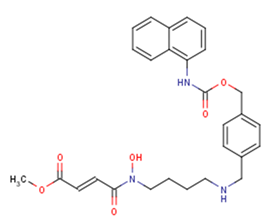
Methylstat
CAS No. 1310877-95-2
Methylstat( Methylstat )
Catalog No. M19349 CAS No. 1310877-95-2
Methylstat is a methyl ester prodrug of a Jumonji C domain-containing histone demethylase (JMJD) inhibitor that has favorable cell permeability.
Purity : >98% (HPLC)
 COA
COA
 Datasheet
Datasheet
 HNMR
HNMR
 HPLC
HPLC
 MSDS
MSDS
 Handing Instructions
Handing Instructions
| Size | Price / USD | Stock | Quantity |
| 5MG | 74 | Get Quote |


|
| 100MG | Get Quote | Get Quote |


|
| 200MG | Get Quote | Get Quote |


|
| 500MG | Get Quote | Get Quote |


|
| 1G | Get Quote | Get Quote |


|
Biological Information
-
Product NameMethylstat
-
NoteResearch use only, not for human use.
-
Brief DescriptionMethylstat is a methyl ester prodrug of a Jumonji C domain-containing histone demethylase (JMJD) inhibitor that has favorable cell permeability.
-
DescriptionMethylstat is a methyl ester prodrug of a Jumonji C domain-containing histone demethylase (JMJD) inhibitor that has favorable cell permeability. The free acid of methylstat inhibits JMJD2A, JMJD2C, JMJD2E, PHF8, and JMJD3 with IC50 values of approximately 4.3, 3.4, 5.9, 10, and 43 μM, respectively, in an in vitro assay. Methylstat inhibits growth of the JMJD2C-sensitive esophageal cancer cell line KYSE150 with a GI50 of 5.1 μM, whereas the free acid of methylstat did not inhibit cell growth up to 100 μM. Methylstat induces histone hypermethylation at multiple sites in a concentration-dependent manner (EC50 for H3K4me3 and H3K9me3 = 10.3 and 8.6 μM in KYSE150 cells and 6.7 ad 6.3 μM in MCF-7 cells, respectively).
-
In VitroMethylstat (0-5 μM; 48, 72 h) shows anti-proliferative activity with no cytotoxicity on HUVECs at 1-2 μM.Methylstat (0, 1, 2 μM; 48 h) induces cell cycle arrest at G0/G1 phase in a dose-dependent manner.Methylstat (0, 1, 2 μM; 48 h) increases the expression of p53 mRNA levels, the H3K27 methylation levels and the accumulation of p53 and p21 protein levels, but suppresses the protein level of cyclinD1.Methylstat (0, 1, 2 μM) shows anti-angiogenic activity induced by VEGF, bFGF and TNF-α in HUVEC cells, and inhibits the f capillary formation during CAM (chick embryo chorioallantoic membrane) development without any sign of thrombosis and hemorrhage.Methylstat (1.1, 2.2 mM for U266 cells, 2.1, 4.2 mM for ARH77 cells; 72 h) induces apoptosis significantly in U266 and ARH77 cells. Cell Cytotoxicity Assay Cell Line:HUVEC cells Concentration:0-5 μMIncubation Time:48, 72 h Result:Did not exhibit cytotoxicity on HUVECs at 1-2 μM.Cell Viability Assay Cell Line:HUVEC, HepG2, HeLa, CHANG cells Concentration:0-5 μM Incubation Time:72 h Result:Showed anti-proliferative activity with IC50s of 4, 10, 5, 7.5 μM for HUVEC, HepG2, HeLa, CHANG cells, respectively.Cell Cycle Analysis Cell Line:HUVEC cells Concentration:0, 1, 2 μM Incubation Time:48 h Result:G0/G1 phase increased 16.8% compared to non-treated cells, whereas S and G2/M decreased 5.5% and 6.1% respectively.Western Blot Analysis Cell Line:HUVEC cells Concentration:0, 1, 2 μM Incubation Time:0-48 h Result:Resulted in accumulation of p53 and p21 protein levels in a time- and dose-dependent manner and increased the H3K27 methylation levels, the but suppressed the protein level of cyclinD1.Apoptosis Analysis Cell Line:U266, ARH77 cells Concentration:1.1, 2.2 mM for U266 cells, 2.1, 4.2 mM for ARH77 cells Incubation Time:72 h Result:Induced apoptosis in U266, ARH77 cells.
-
In Vivo——
-
SynonymsMethylstat
-
PathwayOthers
-
TargetOther Targets
-
RecptorJMJD2A| JMJD2C| JMJD2E| PHF8| JMJD3
-
Research Area——
-
Indication——
Chemical Information
-
CAS Number1310877-95-2
-
Formula Weight505.56
-
Molecular FormulaC28H31N3O6
-
Purity>98% (HPLC)
-
SolubilityIn Vitro:?DMSO : 100 mg/mL (197.80 mM)
-
SMILESO=C(OC)/C=C/C(N(O)CCCCNCC1=CC=C(COC(NC2=C3C=CC=CC3=CC=C2)=O)C=C1)=O
-
Chemical Name(2E)-4-[Hydroxy[4-[[[4-[[[(1-naphthalenylamino)carbonyl]oxy]methyl]phenyl]methyl]-amino]butyl]amino]-4-oxo-2-butenoic acid methyl ester
Shipping & Storage Information
-
Storage(-20℃)
-
ShippingWith Ice Pack
-
Stability≥ 2 years
Reference
1. Luo, X., et al. Journal of the American Chemical Society 133(24), 9451-9456 (2011).
molnova catalog



related products
-
MDL-28170
Calpain Inhibitor III is a potent, cell-permeable inhibitor of calpain I and II (Ki = 8 nM)., The Calpain Inhibitor III, also referenced under CAS 88191-84-8, controls the biological activity of Calpain.
-
5,7,8-Trimethoxycoum...
5,7,8-Trimethoxycoumarin is a natural product of Viola, Violaceae. 5,7,8-Trimethoxycoumarin can be used as a reference standard.
-
(3R)-5,7-Dihydroxy-6...
(3R)-5,7-Dihydroxy-6-methyl-3-(4'-hydroxybenzyl)chroman-4-one is a natural product.



 Cart
Cart
 sales@molnova.com
sales@molnova.com


